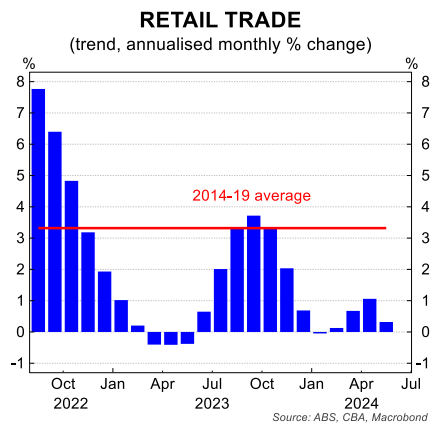According to the Australian Bureau of Statistics (ABS), the value of Australian retail sales rose by 0.6% in May, beating consensus expectations of a 0.2% rise.
Source: AMP
Robert Ewing, ABS head of business statistics, stated that sales were pulled forward by early mid-year sales and large sporting events:
“Retail turnover was boosted this month by watchful shoppers taking advantage of early end-of-financial year promotions and sales events”.
Advertisement
“Retail businesses continue to rely on discounting and sales events to stimulate discretionary spending, following restrained spending in recent months”.
“Despite the seasonally adjusted rise, underlying spending remains stagnant with retail turnover flat in trend terms. Compared to May 2023, trend is only up 1.5%”…
“Large cultural events continue to impact cafes, restaurants and takeaway food services, with the fall in May a reversal of increased spending associated with LIV Golf Adelaide and the AFL Gather Round in South Australia last month”.
Thus, we should expect some pullback in June.
The trend data provides a clearer picture on the state of consumer spending:

“On that score, underlying spending remains motionless. Retail turnover was flat in trend terms over May. And the annual rate of total nominal retail spending sits at just 1.7%”, noted Gareth Aird, head of Australian economics at CBA.
“The volume of retail sales is likely to be down again over the quarter. This has been a familiar theme for most of the past two years. Things of course look a lot weaker on a per-capita basis given population growth is ~2.5%/yr”, noted Aird.
Advertisement
Indeed, the next chart from Shane Oliver at AMP noted that real retail sales per person are down around 7.5% from their November 2021 high:

Source: AMP
Gareth Aird notes that the Stage 3 tax cuts and energy rebates will “provide some marginal support for consumer spending in 2024/25”.
Advertisement
However, the RBA will need to cut interest rate cuts for household spending to lift more to a trend-like pace.

